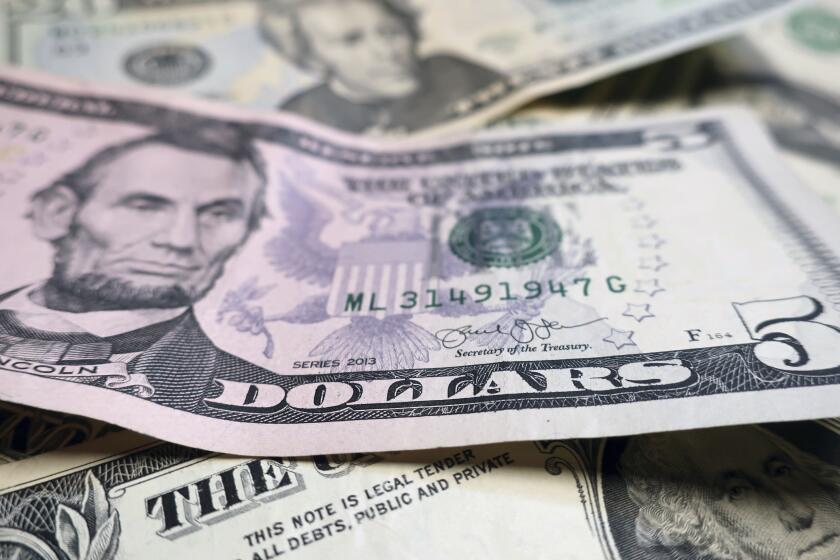U.S. stocks end mixed in manic day following Trump’s latest tariff threat

- Share via
NEW YORK — U.S. stocks careened through a manic Monday after President Trump threatened to crank his tariffs higher, despite a stunning display showing how dearly Wall Street wants him to do the opposite.
The Standard & Poor’s 500 index slipped 0.2% at the end of a day full of heart-racing reversals as battered financial markets try to figure out what Trump’s ultimate goal is for his trade war. If it’s to get other countries to agree to trade deals, he could lower his tariffs and avoid a possible recession. But if it’s to remake the economy and stick with tariffs for the long haul, stock prices may need to fall further.
The Dow Jones industrial average fell 0.9%, and the Nasdaq composite edged up by 0.1%.
All three indexes started the day sharply lower, and the Dow plunged as many as 1,700 points after even worse losses elsewhere in the world. But it suddenly surged to a gain of nearly 900 points in the late morning. The S&P 500, meanwhile, went from a loss of 4.7% to a leap of 3.4%, which would have been its biggest jump in years.
The sudden rise followed a false rumor that Trump was considering a 90-day pause on his tariffs, one that a White House account on X quickly labeled as “fake news.” That a rumor could move trillions of dollars’ worth of investments shows how much investors are hoping to see signs that Trump may let up on tariffs.
Stocks quickly turned back down, and shortly afterward, Trump dug in further and said he may raise tariffs higher against China after the world’s second-largest economy retaliated last week with its own set of tariffs on U.S. products.
It’s a slap in the face to Wall Street because it suggests that Trump may not care how much pain he inflicts on the market. Many professional investors had long thought that a president who used to crow about records reached under his watch would pull back on policies if they sent the Dow reeling.
On Sunday, Trump told reporters aboard Air Force One that he wasn’t concerned about a sell-off and that “sometimes you have to take medicine to fix something.”
Trump has given several reasons for his stiff tariffs, including to bring manufacturing jobs back to the United States, which is a process that could take years. Trump on Sunday said that he wanted to bring down the numbers for how much more the United States imports from other countries versus how much it sends to them.
Indexes swung between losses and gains Monday after Trump’s latest tariff threat, in part because hope remains in markets that negotiations may still come.
“We’re not calling the all-clear at all, but when you have this type of volatility in the market, of course you’re going to have back and forth” in markets not just day to day but also hour to hour, said Nate Thooft, a senior portfolio manager at Manulife Investment Management.
“We’re all waiting for the next bit of information,” he said. “Literally a Truth Social tweet or an announcement of some sort about real negotiations could dramatically move this market. This is the world we live in right now.”
The Trump administration’s tariffs will significantly hurt Silicon Valley tech companies like Apple, which has manufacturing operations in China, Vietnam and India.
All that seemed certain Monday was the financial pain hammering investments around the world for a third day after Trump announced tariffs in his “Liberation Day.”
Stocks in Hong Kong plunged 13.2% for their worst day since 1997. A barrel of benchmark U.S. crude oil fell below $60 during the morning for the first time since 2021, hurt by worries that a global economy weakened by trade barriers will burn less fuel. Bitcoin sank below $79,000, down from its record above $100,000 set in January, after holding steadier than other markets last week.
Trump’s tariffs are an attack on the globalization that’s remade the world’s economy, which helped bring down prices for products on the shelves of U.S. stores but also caused production jobs to leave for other countries.
It also adds pressure on the Federal Reserve. Investors have become nearly conditioned to expect the central bank to swoop in as a hero by slashing interest rates to protect the economy during every downturn.
But the Fed may have less freedom to act this time around because inflation remains higher than the Fed would like. And although lower interest rates can boost the economy, they also can put upward pressure on inflation.
Heading into this year, most U.S. farmers were hoping to break even or maybe record a small profit. But Trump’s tariffs have created new anxiety.
Kurtenbach, Choe and McHugh write for the Associated Press.
More to Read
Inside the business of entertainment
The Wide Shot brings you news, analysis and insights on everything from streaming wars to production — and what it all means for the future.
You may occasionally receive promotional content from the Los Angeles Times.












